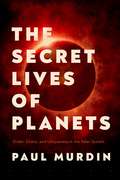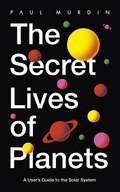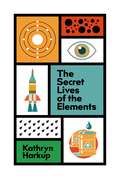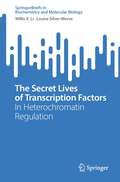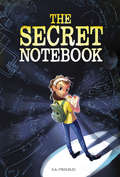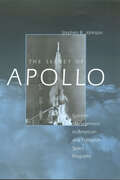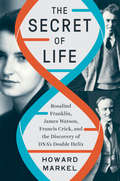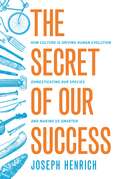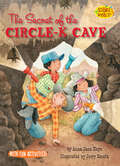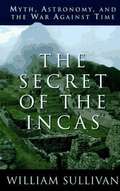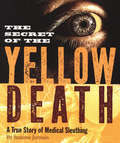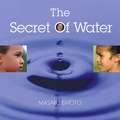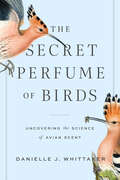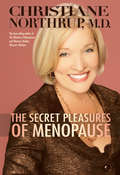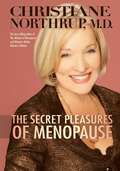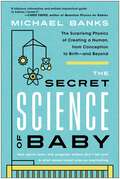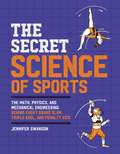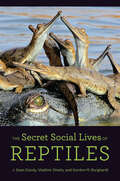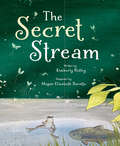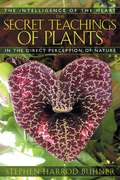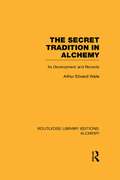- Table View
- List View
The Secret Lives of Planets: Order, Chaos, And Uniqueness In The Solar System
by Paul MurdinAn insider's guide to astronomy reveals everything you need to know about the planets, their satellites, and our place in the solar system.We have the impression that the solar system is perfectly regular like a clock or a planetarium instrument. On a short timescale it is. But, seen in a longer perspective, the planets, and their satellites, have exciting lives, full of events. For example, did you know that Saturn&’s moon, Titan, boasts lakes which contain liquid methane surrounded by soaring hills and valleys, exactly as the earth did before life evolved on our fragile planet? Or that Mercury is the shyest planet? Or, that Mars&’s biggest volcano is one hundred times the size of Earth&’s, or that its biggest canyon is ten times the depth of the Grand Canyon, or that it wasn&’t always red, but blue? The culmination of a lifetime of astronomy and wonder, Paul Murdin&’s enchanting new book reveals everything you ever wanted to know about the planets, their satellites, and our place in the solar system.
The Secret Lives of Planets: A User's Guide to the Solar System – BBC Sky At Night's Best Astronomy and Space Books of 2019
by Paul Murdin'A deft, frequently dramatic tour'Nature'A wonderfully clear and readable book . . . Gives a splendid overview of our Sun's planetary system, including its history and exploration'Dame Jocelyn Bell Burnell*We have the impression that the solar system is perfectly regular like a clock, or a planetarium instrument. On a short timescale it is. But, seen in a longer perspective, the planets, and their satellites, have exciting lives, full of events - for example, did you know that Saturn's moon, Titan, boasts lakes which contain liquid methane surrounded by soaring hills and valleys, exactly as the earth did before life evolved on our fragile planet? Or that Mercury is the shyest planet? Or, that Mars' biggest volcano is 100 times the size of Earth's, or that its biggest canyon is 10 times the depth of the Grand Canyon, or that it wasn't always red, but blue? The culmination of a lifetime of astronomy and wonder, Paul Murdin's enchanting new book reveals everything you ever wanted to know about the planets, their satellites, and our place in the solar system.
The Secret Lives of Planets: A User's Guide to the Solar System
by Paul MurdinWe have the impression that the solar system is perfectly regular like a clock, or a planetarium instrument. On a short timescale it is. But, seen in a longer perspective, the planets, and their satellites, have exciting lives, full of events - for example, did you know that Saturn's moon, Titan, boasts lakes which contain liquid methane surrounded by soaring hills and valleys, exactly as the earth did before life evolved on our fragile planet? Or that Mercury is the shyest planet? Or, that Mars' biggest volcano is 100 times the size of Earth's, or that its biggest canyon is 10 times the depth of the Grand Canyon, or that it wasn't always red, but blue? The culmination of a lifetime of astronomy and wonder, Paul Murdin's enchanting new book reveals everything you ever wanted to know about the planets, their satellites, and our place in the solar system.
The Secret Lives of Planets: A User's Guide to the Solar System – BBC Sky At Night's Best Astronomy and Space Books of 2019
by Paul MurdinAn inside guide by astronomer Paul Murdin revealing everything you need to know about the planets, their satellites and our place in the solar system.We have the impression that the solar system is perfectly regular like a clock, or a planetarium instrument. On a short timescale it is. But, seen in a longer perspective, the planets, and their satellites, have exciting lives, full of events - for example, did you know that Saturn's moon, Titan, boasts lakes which contain liquid methane surrounded by soaring hills and valleys, exactly as the earth did before life evolved on our fragile planet? Or that Mercury is the shyest planet? Or, that Mars' biggest volcano is 100 times the size of Earth's, or that its biggest canyon is 10 times the depth of the Grand Canyon, or that it wasn't always red, but blue? The culmination of a lifetime of astronomy and wonder, Paul Murdin's enchanting new book reveals everything you ever wanted to know about the planets, their satellites, and our place in the solar system.(P)2019 Hodder & Stoughton Limited
The Secret Lives of the Elements
by Kathryn Harkup'A delightful and engaging treasure trove of a book that brings the chemical elements to life and gives them personalities of their own. A wonderful read for young and old alike to get you inspired by chemistry.' Jim Al-Khalili 'The perfect book to escape our human-sized existence and take a tour of the atomic world instead.' Helen Arney, science comedian and broadcasterWhen we think of the periodic table we picture orderly rows of elements that conform to type and never break the rules. In this book Kathryn Harkup reveals that there are personalities, passions, quirks and historical oddities behind those ordered rows, and shows us that the periodic table is a sprawling family tree with its own black sheep, wayward cousins and odd uncles. The elements in the periodic table, like us, are an extended family - some old, some newborn, some shy and reticent, some exuberant or unreliable. Dr Harkup tells the weird and wonderful stories of just fifty two members of this family - remarkable tales of discovery, inspiration and revolution, from the everyday to the extraordinary. Some elements are relatively anonymous; others, already familiar, are seen in a new light; and old friends have surprising secrets to share. From our green-fingered friend magnesium to the devil incarnate polonium, this eclectic collection of engaging and informative stories will change the way you see the periodic table for ever.
The Secret Lives of the Elements
by Kathryn Harkup'A delightful and engaging treasure trove of a book that brings the chemical elements to life and gives them personalities of their own. A wonderful read for young and old alike to get you inspired by chemistry.' Jim Al-Khalili 'The perfect book to escape our human-sized existence and take a tour of the atomic world instead.' Helen Arney, science comedian and broadcasterWhen we think of the periodic table we picture orderly rows of elements that conform to type and never break the rules. In this book Kathryn Harkup reveals that there are personalities, passions, quirks and historical oddities behind those ordered rows, and shows us that the periodic table is a sprawling family tree with its own black sheep, wayward cousins and odd uncles. The elements in the periodic table, like us, are an extended family - some old, some newborn, some shy and reticent, some exuberant or unreliable. Dr Harkup tells the weird and wonderful stories of just fifty two members of this family - remarkable tales of discovery, inspiration and revolution, from the everyday to the extraordinary. Some elements are relatively anonymous; others, already familiar, are seen in a new light; and old friends have surprising secrets to share. From our green-fingered friend magnesium to the devil incarnate polonium, this eclectic collection of engaging and informative stories will change the way you see the periodic table for ever.
The Secret Lives of Transcription Factors: In Heterochromatin Regulation (SpringerBriefs in Biochemistry and Molecular Biology)
by Willis X. Li Louise Silver-MorseThis SpringerBrief explores unconventional functions of eight different transcription factors and concludes with a discussion of their biological significance and impact, including effects on processes within the cell nucleaus during development and in adult organisms. Chapter One details unconventional functions of the transcription factors GAGA, HP1, Rb, STAT, ATF-2 and NF-kB. Surprisingly, all of these transcription factors can be found in association with heterochromatin as well as euchromatin, and in some cases unconventional functions have been demonstrated for these heterochromatin-associated factors. Chapter Two focuses on the unconventional functions of STAT and HP1 and discusses their roles in the promotion of longevity, and in protection from cancer and DNA damage. Chapter Three explores the biological significance of the findings presented in the first two chapters and considers how global changes in the epigenome brought about by factors such as STAT and HP1 might affect processes within the cell nucleus during development and in adult organisms. This succinct yet thorough SpringerBrief is essential for researchers studying epigenetics, and to instructors of the subject. It should also appeal to people interested in the control of gene transcription and other processes in the cell nucleus, and to those interested in development.
The Secret Notebook
by D.A. D'AurelioRiley Green is certain her lie detector pen will improve her status in a school full of kids from the most powerful families of Washington, D.C. But her plan collapses when her invention idea is stolen, her favorite teacher goes missing, and mysterious threats begin to appear around capital. Before vanishing, Riley's teacher entrusts her with her most prized possession, the lost notebook of Nikola Tesla, legendary inventor and scientist. Now Riley and her friends must protect the notebook from thieves who want to steal the details it holds about a dangerous invention. When Riley discovers another secret, she must decode a mysterious message before it's too late. Her teacher's life depends on it.
The Secret of Apollo: Systems Management in American and European Space Programs (New Series in NASA History)
by Stephen B. JohnsonWinner of the Emme Award for Astronautical Literature from the American Astronautical SocietyHow does one go about organizing something as complicated as a strategic-missile or space-exploration program? Stephen B. Johnson here explores the answer—systems management—in a groundbreaking study that involves Air Force planners, scientists, technical specialists, and, eventually, bureaucrats. Taking a comparative approach, Johnson focuses on the theory, or intellectual history, of "systems engineering" as such, its origins in the Air Force's Cold War ICBM efforts, and its migration to not only NASA but the European Space Agency.Exploring the history and politics of aerospace development and weapons procurement, Johnson examines how scientists and engineers created the systems management process to coordinate large-scale technology development, and how managers and military officers gained control of that process. "Those funding the race demanded results," Johnson explains. "In response, development organizations created what few expected and what even fewer wanted—a bureaucracy for innovation. To begin to understand this apparent contradiction in terms, we must first understand the exacting nature of space technologies and the concerns of those who create them."
The Secret of Life: Rosalind Franklin, James Watson, Francis Crick, And The Discovery Of Dna's Double Helix
by Howard MarkelAn authoritative history of the race to unravel DNA’s structure, by one of our most prominent medical historians. James Watson and Francis Crick’s 1953 discovery of the double helix structure of DNA is the foundation of virtually every advance in our modern understanding of genetics and molecular biology. But how did Watson and Crick do it—and why were they the ones who succeeded? In truth, the discovery of DNA’s structure is the story of five towering minds in pursuit of the advancement of science, and for almost all of them, the prospect of fame and immortality: Watson, Crick, Rosalind Franklin, Maurice Wilkins, and Linus Pauling. Each was fascinating and brilliant, with strong personalities that often clashed. Howard Markel skillfully re-creates the intense intellectual journey, and fraught personal relationships, that ultimately led to a spectacular breakthrough. But it is Rosalind Franklin—fiercely determined, relentless, and an outsider at Cambridge and the University of London in the 1950s, as the lone Jewish woman among young male scientists—who becomes a focal point for Markel. The Secret of Life is a story of genius and perseverance, but also a saga of cronyism, misogyny, anti-Semitism, and misconduct. Drawing on voluminous archival research, including interviews with James Watson and with Franklin’s sister, Jenifer Glynn, Markel provides a fascinating look at how science is done, how reputations are undone, and how history is written, and revised. A vibrant evocation of Cambridge in the 1950s, Markel also provides colorful depictions of Watson and Crick—their competitiveness, idiosyncrasies, and youthful immaturity—and compelling portraits of Wilkins, Pauling, and most cogently, Rosalind Franklin. The Secret of Life is a lively and sweeping narrative of this landmark discovery, one that finally gives the woman at the center of this drama her due.
The Secret of Our Success: How Culture Is Driving Human Evolution, Domesticating Our Species, and Making Us Smarter
by Joseph HenrichHumans are a puzzling species. On the one hand, we struggle to survive on our own in the wild, often failing to overcome even basic challenges, like obtaining food, building shelters, or avoiding predators. On the other hand, human groups have produced ingenious technologies, sophisticated languages, and complex institutions that have permitted us to successfully expand into a vast range of diverse environments. What has enabled us to dominate the globe, more than any other species, while remaining virtually helpless as lone individuals? This book shows that the secret of our success lies not in our innate intelligence, but in our collective brains--on the ability of human groups to socially interconnect and learn from one another over generations. Drawing insights from lost European explorers, clever chimpanzees, mobile hunter-gatherers, neuroscientific findings, ancient bones, and the human genome, Joseph Henrich demonstrates how our collective brains have propelled our species' genetic evolution and shaped our biology. Our early capacities for learning from others produced many cultural innovations, such as fire, cooking, water containers, plant knowledge, and projectile weapons, which in turn drove the expansion of our brains and altered our physiology, anatomy, and psychology in crucial ways. Later on, some collective brains generated and recombined powerful concepts, such as the lever, wheel, screw, and writing, while also creating the institutions that continue to alter our motivations and perceptions. Henrich shows how our genetics and biology are inextricably interwoven with cultural evolution, and how culture-gene interactions launched our species on an extraordinary evolutionary trajectory. Tracking clues from our ancient past to the present, The Secret of Our Success explores how the evolution of both our cultural and social natures produce a collective intelligence that explains both our species' immense success and the origins of human uniqueness.
The Secret of the Circle-K Cave (Science Solves It!)
by Anna Jane HaysSolve kid-sized dilemmas and mysteries with the Science Solves It! series. These fun books for kids ages 5–8 blend clever stories with real-life science. Why did the dog turn green? Can you control a hiccup? Is that a UFO? Find the answers to these questions and more as kid characters dive into physical, life, and earth sciences. Rick is headed out west to his aunt and uncle&’s dude ranch. He gets to ride a horse and see the local wildlife. But best of all, Rick and his cousins find a cool cave nearby. Maybe the cave holds the key to a century-old stagecoach robbery! Books in this perfect STEM series will help kids think like scientists and get ahead in the classroom. Activities and experiments are included in every book! (Level One; Science topic: Caves)
The Secret of the Incas: Myth, Astronomy and the War Against Time
by William SullivanThe Inca Empire, at its peak, was the largest kingdom on Earth. The Incas were known as master builders, fearsome warriors, and practitioners of human sacrifice. Yet in the year 1532, this mighty state was conquered, overnight, by fewer than 200 Spanish adventurers. How could this happen? That question begins William Sullivan's brilliant and profound book, The Secret of the Incas. Like Heinrich Schliemann's discovery of Troy, Sullivan's discovery of the historical truth hidden in the myths of the Andes is a thrilling historical detective story. At the same time, it recalls the work of Joseph Campbell, finding new meaning in ancient legends. Step by step, clue by clue, Sullivan decodes the myths of the Incas to reveal that they embody an astoundingly thorough record of astronomical events--a record so precise it can be checked against a modern computer program. And he uncovers the Incas' tragic secret: they knew they were doomed. As they watched the skies for over a thousand years, the priest-astronomers of the Andes came to believe that great transitions in the heavens foretold great transitions here on earth. In the fifteenth century, they read the sky and saw the signs of an apocalypse. So the Incas took a desperate gamble: if events in the heavens could influence those on earth, perhaps the reverse was true. Their rituals of warfare and human sacrifice were nothing less than an attempt to stop time, to forestall the cataclysm that would sweep their world away. The Inca gamble failed, for just at the time the prophecy predicted, the Conquistadors arrived. Yet even as their world collapsed, the Andean shamans set their wisdom afloat in the waters of time, aboard the vessel of myth. In this book, after four centuries of oblivion, their message has been received.
The Secret of the Yellow Death: A True Story of Medical Sleuthing
by Suzanne JurmainRed oozes from the patient's gums. He has a rushing headache and the whites of his eyes look like lemons. He will likely die within days. Here is the true story of how four Americans and one Cuban tracked down a killer, one of the word's most vicious plagues: yellow fever. Set in fever-stricken Cuba, the reader feels the heavy air, smell the stench of disease, hear the whine of mosquitoes biting human volunteers during the surreal experiments. Exploring themes of courage, cooperation, and the ethics of human experimentation, this gripping account is ultimately a story of the triumph of science.
The Secret of Water
by Masaru EmotoDr. Masaru Emoto's stunning water-crystal photographs have enchanted millions of people in his many books. His groundbreaking work has shown that thoughts and words have a direct effect on water- crystal formation, and since our bodies are mostly water, our thoughts and words certainly affect not only ourselves but the world around us. In The Secret of Water, Dr. Emoto brings water's message of love, peace, and hope to the next generation in his first children's book. Entertaining and educational, this book offers an understanding of water that will encourage parents and children alike to value and give thanks to our most precious resource. In 2003 the United Nations proclaimed the years 2005 to 2015 as its International Water for Life Decade, which urges citizens of the world to take individual responsibility to learn all about water. In a time wrought with environmental catastrophes and natural disasters, The Secret of Water shows the necessity of protecting water and offers a message of hope and empowerment. Help us shift consciousness
The Secret of Water
by Masaru EmotoMasaru Emoto's photography and spiritual thinking has enabled us to understand more clearly how our actions effect our environment. His insight into water has reached millions of adults around the world and now, with his first book aimed at children, a younger audience can receive his message and help to lead the world toward healing and progress. This comprehensive, easy-to-understand guide to his theories is attractively packaged for children so they too can learn about the power and hidden messages in water.
The Secret Perfume of Birds: Uncovering the Science of Avian Scent
by Danielle J. WhittakerThe untold story of a stunning discovery: not only can birds smell, but their scents may be the secret to understanding their world.The puzzling lack of evidence for the peculiar but widespread belief that birds have no sense of smell irked evolutionary biologist Danielle Whittaker. Exploring the science behind the myth led her on an unexpected quest investigating mysteries from how juncos win a fight to why cowbirds smell like cookies. In The Secret Perfume of Birds—part science, part intellectual history, and part memoir—Whittaker blends humor, clear writing, and a compelling narrative to describe how scent is important not just for birds but for all animals, including humans.Whittaker engagingly describes how emerging research has uncovered birds' ability to produce complex chemical signals that influence their behavior, including where they build nests, when they pick a fight, and why they fly away. Mate choice, or sexual selection—a still enigmatic aspect of many animals' lives—appears to be particularly influenced by smell. Whittaker's pioneering studies suggest that birds' sexy (and scary) signals are produced by symbiotic bacteria that manufacture scents in the oil that birds stroke on their feathers when preening. From tangerine-scented auklets to her beloved juncos, redolent of moss, birds from across the world feature in Whittaker's stories, but she also examines the smelly chemicals of all kinds of creatures, from iguanas and bees to monkeys and humans. Readers will enjoy a rare opportunity to witness the twisting roads scientific research can take, especially the challenging, hilarious, and occasionally dangerous realities of ornithology in the wild. The Secret Perfume of Birds will interest anyone looking to learn more about birds, about how animals and humans use our senses, and about why it can sometimes take a rebel scientist to change what we think we know for sure about the world—and ourselves.
The Secret Pleasures of Menopause: A Guide To Creating Vibrant Health Through Pleasure
by Christiane NorthrupThe Secret Pleasures of Menopause is a groundbreaking book that is long overdue! Christiane Northrup, M.D., delivers a breakthrough message that will help millions and millions of perimenopausal and menopausal women just like you understand that at menopause . . . life has just begun! It is the beginning of a very exciting and fulfilling time, full of pleasure beyond your wildest dreams! Dr. Northrup believes that it's time for you to step forward and learn to enjoy the best years of your life! Even though studies show that menopause doesn't decrease libido, ease of reaching orgasm, or sexual satisfaction, the majority of menopausal women aren't experiencing the pleasure and sexual satisfaction that is their birthright. It is a long-held misconception that menopause signals "the beginning of the end," and nothing could be further from the truth. In this fascinating book, Dr. Northrup candidly guides you toward experiencing life after 50 as the most pleasurable time of your life!
The Secret Science of Baby: The Surprising Physics of Creating a Human, from Conception to Birth--and Beyond
by Michael BanksWhat stops pregnant women from falling over all the time? What makes infant cries so captivating? How do sperm swim? The Secret Science of Baby answers these questions and many more, revealing the fascinating physics behind conception, birth, and babyhood. Parents and parents-to-be are bombarded with information, from what to expect to what to do (and not to do) when it happens. But what they may not realize is that from the chemistry of pregnancy tests to the vacuum physics of breastfeeding, there is fascinating science at the heart of every aspect of creating and raising a new human. Written by science journalist Michael Banks, The Secret Science of Baby won&’t tell you how to raise a perfect violin-playing, mandarin-speaking toddler, but it will shed a new light on how and why things happen as they do—from conception and pregnancy to cooing and pooing. Exploring the hidden physics behind uterine contractions, the fluid dynamics of diapers, and more, both parents and curious non-parents (who, after all, were once babies themselves) will gain a fresh perspective on the infant universe . . . and the thrilling science that makes it possible. In these pages, readers will discover: The physics of the playground and common toys—from the swing to the Slinky What it really means to "sleep like a baby" The surprising shared vocal cord features of lions and (human) infants The miracle of a baby's first breath and how surface tension provided the key to helping preemies breathe Banks draws from his own experience, interviews with scientists, and the latest research (including some involving conception inside an MRI machine) to offer a book that focuses on &“how?&” rather than &“how-to.&” The result is an illuminating and hilarious journey through the everyday science of making, baking, and bringing up baby.
The Secret Science of Sports: The Math, Physics, and Mechanical Engineering Behind Every Grand Slam, Triple Axel, and Penalty Kick
by Jennifer SwansonWhy does a football spiral? How do some athletes jump so high? The answer is science! The Secret Science of Sports helps kids better understand concepts of science, technology, engineering, and math through the sports they love to play and watch. Every sport -- from baseball to basketball, to football and soccer, to wrestling, tennis, and lacrosse -- involves a bit of science, technology, engineering, and math. You can't throw a ball without Newton's Law of Motion, and you can't calculate a player's stats without math. And every type of sports equipment -- a helmet, cleats, shoulder or knee pads -- were designed with the latest engineering and technology. The Secret Science of Sports breaks down normally difficult STEM concepts like forces of motion, gravity, algebra, and even neuroscience, in a language kids can -- and will want to -- understand. Divided into sections like chemistry, biology, physics, technology, and more, this handy guide uses examples from sports like soccer, baseball, softball, football, hockey, lacrosse, tennis, and others to explain important STEM concepts for kids ages 8 to 12. They'll learn how to use math to calculate a batter's average, why a tennis racket is shaped the way it is, how biology affects athletic performance, the aerodynamics behind competitive swimsuits, and much more. With dozens of original, captivating illustrations to engage young readers, kids will have fun while learning about key STEM ideas that will prepare them for years of schooling to come.
The Secret Social Lives of Reptiles
by J. Sean Doody Vladimir Dinets Gordon M. BurghardtCovering diverse species from garter snakes to Komodo dragons, this book delves into the evolutionary origins and fascinating details of the mysterious social lives of reptiles.Reptiles have been too often dismissed as dull animals with tiny brains and simple, "asocial" lives. In reality, reptiles engage in a remarkable diversity of complex social behavior. They can live in families; communicate with one another while still in the egg; and hunt, feed, migrate, court, mate, nest, and hatch in groups. In The Secret Social Lives of Reptiles, J. Sean Doody, Vladimir Dinets, and Gordon M. Burghardt—three of the world's leading experts on reptiles—bring together a wave of new research with a synthesis of classic studies to produce the only authoritative look at the social behaviors of the most provocative animals on the planet. The book covers turtles, lizards, snakes, crocodilians, and the enigmatic tuatara. Enhanced with dozens of images, it takes readers through a myriad of social interactions, tendencies, and intimacies ranging from fierce territorial battles to delicate paternal care and from promiscuous pairings to monogamous partnerships. This unique text• explains why reptiles have been neglected as subjects of social behavior studies;• provides numerous examples across all major reptilian groups that overturn the false paradigm of "solitary" reptiles; • explores the sensory, genetic, physiological, life history, and other factors underlying social behavior in reptiles; • presents the case that evolutionary "experiments" found among reptiles offer unparalleled opportunities for understanding how and why social behavior evolves in animals; and• identifies new and developing areas of research helping to reshape our view of reptiles.Revealing the secrets of reptilian social relationships through original quantitative research, field studies, laboratory experiments, and careful analysis of the literature, The Secret Social Lives of Reptiles elevates these fascinating animals to key players in the science of behavioral ecology.
The Secret Stream
by Kimberly RidleyIn this nonfiction picture book, a stream narrates its own natural history as it flows from its headwaters in the mountains to its mouth in the lowlands, introducing the plants and animals that line its banks and live in its waters. The poetic story, combining lyricismwith natural history excellence, is augmented and enriched by informativesidebars and backmatter. Birds, mammals, amphibians, and insects peek out from the beautiful, scientifically accurate illustrations.
The Secret Teachings of Plants: The Intelligence of the Heart in the Direct Perception of Nature
by Stephen Harrod BuhnerReveals the use of direct perception in understanding Nature, medicinal plants, and the healing of human disease• Explores the techniques used by indigenous and Western peoples to learn directly from the plants themselves, including those of Henry David Thoreau, Goethe, and Masanobu Fukuoka, author of The One Straw Revolution• Contains leading-edge information on the heart as an organ of perceptionAll ancient and indigenous peoples insisted their knowledge of plant medicines came from the plants themselves and not through trial-and-error experimentation. Less well known is that many Western peoples made this same assertion. There are, in fact, two modes of cognition available to all human beings--the brain-based linear and the heart-based holistic. The heart-centered mode of perception can be exceptionally accurate and detailed in its information gathering capacities if, as indigenous and ancient peoples asserted, the heart’s ability as an organ of perception is developed.Author Stephen Harrod Buhner explores this second mode of perception in great detail through the work of numerous remarkable people, from Luther Burbank, who cultivated the majority of food plants we now take for granted, to the great German poet and scientist Goethe and his studies of the metamorphosis of plants. Buhner explores the commonalities among these individuals in their approach to learning from the plant world and outlines the specific steps involved. Readers will gain the tools necessary to gather information directly from the heart of Nature, to directly learn the medicinal uses of plants, to engage in diagnosis of disease, and to understand the soul-making process that such deep connection with the world engenders.
The Secret Tradition in Alchemy: Its Development and Records (Routledge Library Editions: Alchemy)
by Arthur Edward WaiteA complete history of alchemy revealing the subject as much more than the attempts in early science of turning base metals into gold or silver, this book goes about intimating the mystical experience underlying hermetic symbolism. It outlines some of the ‘secret’ inner meanings to alchemy - symbolism, metaphysics, and spirituality. This book contains a universe of information and is worthwhile reading for anyone wanting to know more on this engaging subject. Originally published in 1926.
